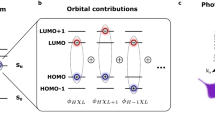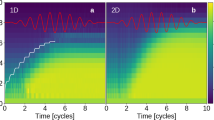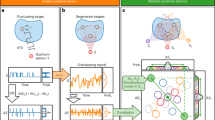Abstract
Competition between electron localization and delocalization in Mott insulators underpins the physics of strongly correlated electron systems. Photoexcitation, which redistributes charge, can control this many-body process on the ultrafast timescale1,2. So far, time-resolved studies have been carried out in solids in which other degrees of freedom, such as lattice, spin or orbital excitations3,4,5, dominate. However, the underlying quantum dynamics of ‘bare’ electronic excitations has remained out of reach. Quantum many-body dynamics are observed only in the controlled environment of optical lattices6,7 where the dynamics are slower and lattice excitations are absent. By using nearly single-cycle near-infrared pulses, we have measured coherent electronic excitations in the organic salt ET-F2TCNQ, a prototypical one-dimensional Mott insulator. After photoexcitation, a new resonance appears, which oscillates at 25 THz. Time-dependent simulations of the Mott–Hubbard Hamiltonian reproduce the oscillations, showing that electronic delocalization occurs through quantum interference between bound and ionized holon–doublon pairs.
This is a preview of subscription content, access via your institution
Access options
Subscribe to this journal
Receive 12 print issues and online access
$259.00 per year
only $21.58 per issue
Buy this article
- Purchase on SpringerLink
- Instant access to full article PDF
Prices may be subject to local taxes which are calculated during checkout




Similar content being viewed by others
Change history
09 December 2010
In the version of this Letter originally published online, the x axis of Fig. 4a was incorrect. This has now been corrected in all versions of the Letter.
References
Zu, G. et al. Transient photoinduced conductivity in single crystals of YBa2Cu3O6.3: Photodoping to the metallic state. Phys. Rev. Lett. 67, 2581–2584 (1991).
Miyano, K., Tanaka, T., Tomioka, Y. & Tokura, Y. Photoinduced insulator-to-metal transition in a perovskite manganite. Phys. Rev. Lett. 78, 4257–4260 (1997).
Cavalleri, A. et al. Evidence for a structurally-driven insulator-to-metal transition in VO2: A view from the ultrafast timescale. Phys. Rev. B 70, 161102 (2004).
Wall, S., Prabhakaran, D., Boothroyd, A. T. & Cavalleri, A. Ultrafast coupling between light, coherent lattice vibrations, and the magnetic structure of semicovalent LaMnO3 . Phys. Rev. Lett. 103, 097402 (2009).
Polli, D. et al. Coherent orbital waves in the photo-induced insulator–metal dynamics of a magnetoresistive manganite. Nature Mater. 6, 643–647 (2007).
Greiner, M. et al. Quantum phase transition from a superfluid to a Mott insulator in a gas of ultracold atoms. Nature 415, 39–44 (2001).
Greiner, M., Mandel, O., Haensch, T. W. & Bloch, I. Collapse and revival of the matter wave field of a Bose–Einstein condensate. Nature 419, 51–54 (2002).
Koshihara, S. Photoinduced valence instability in the organic molecular compound tetrathiafulvalene-p-chloranil (TTF-CA). Phys. Rev. B. 42, 6853–6856 (1990).
Hasegawa, T. et al. Electronic states and anti-ferromagnetic order in mixed-stack charge-transfer compound (BEDT-TTF)(F2TCNQ). Solid State Commun. 103, 489–493 (1997).
Hasegawa, T. et al. Mixed-stack organic charge-transfer complexes with intercolumnar networks. Phys. Rev. B 62, 10059–10066 (2000).
Okamoto, H. et al. Photoinduced metallic state mediated by spin-charge separation in a one-dimensional organic Mott insulator. Phys. Rev. Lett 98, 037401 (2007).
Brida, D. et al. Sub-two-cycle light pulses at 1.6 μm from an optical parametric amplifier. Opt. Lett. 33, 741–743 (2008).
Kim, K. W., Gu, G. D., Homes, C. C. & Noh, T. W. Bound excitons in Sr2CuO3 . Phys. Rev. Lett. 101, 177404 (2008).
Gomi, H., Takahashi, A., Ueda, T., Itoh, H. & Aihara, M. Photogenerated holon–doublon cluster states in strongly correlated low-dimensional electron systems. Phys. Rev. B 71, 045129 (2005).
Jordens, R. et al. A Mott insulator of fermionic atoms in an optical lattice. Nature 455, 204–207 (2008).
Cavalieri, A. L. et al. Attosecond spectroscopy in condensed matter. Nature 449, 1029–1032 (2007).
Perfetti, L. et al. Time evolution of the electronic structure of 1 T-TaS2 through the insulator–metal transition. Phys. Rev. Lett. 97, 067402 (2006).
Cavalleri, A., Rini, M. & Schoenlein, R. W. Ultra-broadband femtosecond measurements of the photo-induced phase transition in VO2: From the Mid-IR to the hard X-rays. J. Phys. Soc. Jpn 75, 011004 (2006).
Uno, M. et al. A new route to phenylenedimalononitrile and the analogues using palladium-catalyzed carbon–carbon bond formation. Tetrahedron Lett. 26, 1553–1556 (1985).
Acknowledgements
This work was supported by the European Community Access to Research Infrastructure Action, Contract RII3-CT-2003-506350 (Centre for Ultrafast Science and Biomedical Optics, LASERLAB-EUROPE). S.R.C and D.J thank the National Research Foundation and the Ministry of Education of Singapore for support. A.A. is supported by the Royal Society. H.O. is grateful for support by a Grant-in-Aid for Scientific Research (No. 20110005) from the Ministry of Education, Culture, Sports, Science and Technology of Japan.
Author information
Authors and Affiliations
Contributions
S.W., D.B., H.P.E. and G.C. carried out the pump–probe experiments. D.B., S.B. and G.C. designed and built the experimental apparatus. H.U., Y.T., T.H. and H.O. provided samples. S.W. analysed the experimental data. S.R.C. and D.J. carried out the numerical simulations. S.W., A.C., A.A., S.R.C. and D.J. interpreted the data and the simulations. A.C and S.W. wrote the manuscript. A.C. conceived and coordinated the project.
Corresponding authors
Ethics declarations
Competing interests
The authors declare no competing financial interests.
Supplementary information
Supplementary Information
Supplementary Information (PDF 287 kb)
Rights and permissions
About this article
Cite this article
Wall, S., Brida, D., Clark, S. et al. Quantum interference between charge excitation paths in a solid-state Mott insulator. Nature Phys 7, 114–118 (2011). https://doi.org/10.1038/nphys1831
Received:
Accepted:
Published:
Issue date:
DOI: https://doi.org/10.1038/nphys1831
This article is cited by
-
A Hubbard exciton fluid in a photo-doped antiferromagnetic Mott insulator
Nature Physics (2023)
-
Axial Higgs mode detected by quantum pathway interference in RTe3
Nature (2022)
-
Measurement of 10 fs pulses across the entire Visible to Near-Infrared Spectral Range
Scientific Reports (2020)
-
Ultrafast evolution and transient phases of a prototype out-of-equilibrium Mott–Hubbard material
Nature Communications (2017)
-
Non-linear quantum-classical scheme to simulate non-equilibrium strongly correlated fermionic many-body dynamics
Scientific Reports (2016)



